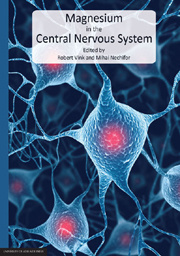Book contents
- Frontmatter
- List of Contributors
- Preface
- Contents
- Section 1 Magnesium in Normal Brain
- Section 2 Magnesium in Neurological Diseases
- Section 3 Involvement of Magnesium in Psychiatric Diseases
- Chapter 18 Magnesium and Alzheimer's disease
- Chapter 19 Magnesium and stress
- Chapter 20 Magnesium in neuroses
- Chapter 21 Magnesium, hyperactivity and autism in children
- Chapter 22 Magnesium in psychoses (schizophrenia, bipolar disorder)
- Chapter 23 Magnesium and major depression
Chapter 21 - Magnesium, hyperactivity and autism in children
from Section 3 - Involvement of Magnesium in Psychiatric Diseases
Published online by Cambridge University Press: 05 June 2012
- Frontmatter
- List of Contributors
- Preface
- Contents
- Section 1 Magnesium in Normal Brain
- Section 2 Magnesium in Neurological Diseases
- Section 3 Involvement of Magnesium in Psychiatric Diseases
- Chapter 18 Magnesium and Alzheimer's disease
- Chapter 19 Magnesium and stress
- Chapter 20 Magnesium in neuroses
- Chapter 21 Magnesium, hyperactivity and autism in children
- Chapter 22 Magnesium in psychoses (schizophrenia, bipolar disorder)
- Chapter 23 Magnesium and major depression
Summary
Abstract
For many years, magnesium has been described as a crucial factor for cellular activity. In this chapter, a brief overview of pharmacology and genetics of magnesium transport will be followed by a review of clinical and biological studies of Mg2+/VitB6 supplementation in attention deficit/hyperactivity disorder (ADHD) and autism (autistic spectrum disorders family, ASD) in children. Although to date, no study carried out on a rational basis has been published, some experimental and/or clinical works support the hypothesis of a positive effect of such therapy in these pathologies. All the individual observations report a decrease in hyperactivity and a stabilization of scholarly behaviour with treatment. These data strongly support the need for a controlled study to confirm or invalidate these assumptions.
Introduction
Magnesium is the second most abundant intracellular cation in the body; its main action is to regulate enzyme activity, to control the activity of various calcium and potassium channels, and to promote membrane stabilization. It is also responsible for the maintenance of the transmembrane gradients of sodium and potassium. Magnesium depletion is known to be associated with many clinical diseases including hypocalcemia, hypokalemia, cardiac arrhythmias, neuromuscular excitability, hypertension, atherosclerosis, and osteoporosis.
- Type
- Chapter
- Information
- Magnesium in the Central Nervous System , pp. 283 - 302Publisher: The University of Adelaide PressPrint publication year: 2011
- 5
- Cited by



